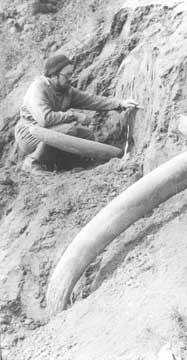|
NEWS NOTES — NEWS
Paleontology
DNA holds clues to extinction
 Courtesy of Andrei Sher |
| Andrei Sher of the Russian Academy of Sciences excavates a huge mammoth tusk near the Keremesit River in northeastern Siberia. A new DNA study is showing that mammoths were in decline before humans hunted them en masse. |
Woolly mammoths called the snowy landscapes of the northern continents home until roughly 11,000 years ago. At that time, their populations disappeared from all but a few island locales, coinciding with the large-scale migration of humans into these areas. Because of this correlation, scientists have long thought human hunting may have caused the woolly mammoth’s demise. Now, a new genetic analysis indicates that woolly mammoths were already on the decline by at least 40,000 years ago, suggesting their extinction was a long, gradual process in which humans were only a small player.
To study woolly mammoth genetics, Ian Barnes of Royal Holloway, University of London and colleagues extracted mitochondrial DNA — DNA inherited only from the mother — from bones, teeth or ivory of more than 40 mammoths, ranging from roughly 12,000 to 50,000 years old, according to radiocarbon dating. By analyzing the similarities and differences in a section of the genetic code, the researchers discovered two distinct genetic lineages, they reported June 19 in Current Biology.
Barnes and his team further found that both genetic lineages existed in the northeastern Siberian population about 50,000 years ago. But 10,000 years later, only one of these genetic lineages was still present. When a population loses some of its genetic variability, it “is indicative of a decrease of population size,” says Mark Thomas, a human evolutionary geneticist at the University College London and co-author of the study. So, he says, it seems the mammoth population was already thinning out when humans came on the scene.
These results are “very interesting,” says Ross MacPhee, a paleobiologist at the American Museum of Natural History in New York. To determine if the results truly represent a “one-way decline” in the species or are just part of a larger “repeating phenomenon” in population changes, MacPhee says researchers should analyze the DNA of a larger number of specimens that go further back in time than those of the current study.
“The $64,000 question,” MacPhee says, is, if humans didn’t cause the extinction of woolly mammoths, then what did? Climatic and environmental changes are usually cited as the likely culprits, he says, but he remains agnostic. Studying a variety of ice age species will help pin down more specifically which factors may have contributed to the woolly mammoth’s extinction, he says.
Thomas and MacPhee both agree that understanding how the forces of extinction worked in the past will help us understand how these forces work today. “Extinctions are complex processes,” Thomas says, “but they are inevitable.”
Links:
"Mapping a woolly mammoth's DNA," Geotimes, May 2006

 Subscribe
Subscribe


